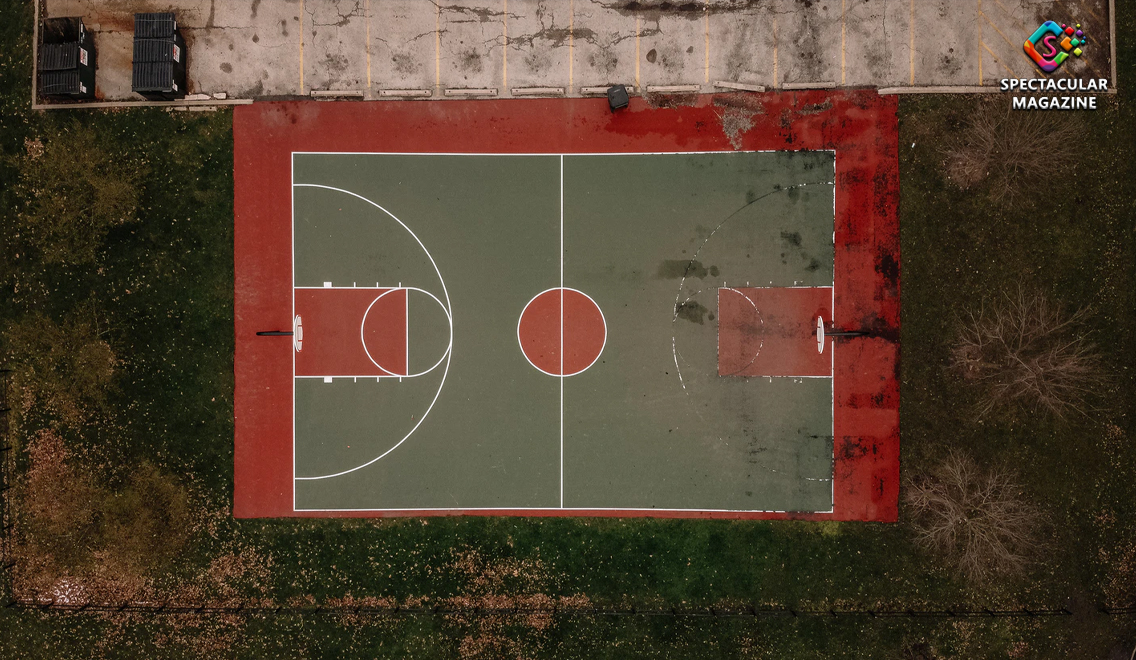Is a High School Basketball Court the Same Size as a College?
 For instance, high school courts differ from college and professionals. In this article, we’ll give you a complete account; take this as a comprehensive guide to fully understand the hoop’s ins and outs, especially regarding court size and requirements.
For instance, high school courts differ from college and professionals. In this article, we’ll give you a complete account; take this as a comprehensive guide to fully understand the hoop’s ins and outs, especially regarding court size and requirements.
What Size Is A Basketball Court?
When it comes to the basketball dimension, it varies on what court you’ll measure. However, there are standards to follow together with several essential factors like the player’s age as the primary users and how much budget you’ll have for builders. A basketball court’s standard size is 94 Ft long x 50 Ft wide. The overall length depends on playing level and league.
Basketball court size regulation:
- Junior High – 74 Ft long x 42 Ft width
- High School – 84 Ft long x 50 Ft width
- College and NBA professional – 94 Ft long x 50 Ft width
While dimension and size vary by league and level, interior markings for foul line and rim and backboard are similar. High school, college, and even professional courts like the NBA come with a distinctive three-point line or arc. The Key In Basketball or the “lane” is different for high school/college and NBA/professionals. For high school and college or NCAA, the standard key is 12 Ft wide. As for professional (NBA) court, the key is 16 Ft wide.
- High school/college (NCAA) = 12Ft wide
- Professionals (NBA) = 16Ft wide
The foul line has a distance of 15 Ft from the backboard front to the foul line for all court levels. Frequently, this measurement is confused from the front rim to the court’s center.
- Regulation basketball courts have a backboard extension of 4Ft from the baseline to the lane/key. A 6-foot half-circle (arc) extension from the foul line to the court’s basket to complete the lane/key.
As for basketball three-point line (arc), there is also a difference in measurement, here’s a quick guide:
- High School Courts: 19 Ft 9 inches
- Men’s/Women’s College Courts: 20 Ft 9 inches
- NBA Courts: 22 FT (from rim center)straight with an extension of 16 Ft 9 inches (from baseline)*
*past these points, line out extension 23Ft 9inches from the rim center.
Do Basketball Courts Have Different Sizes?
 When it comes to basketball court sizes, measurement depends wholly on the level of play and league. As you’ve noticed, court dimensions for college, WNBA, and NBA all have similar measures of 94 ft in length and 50 feet width. The free-throw lane or painted area is 16ft across. The foul line is 15 ft from the backboard front and has a 2 inches width.
When it comes to basketball court sizes, measurement depends wholly on the level of play and league. As you’ve noticed, court dimensions for college, WNBA, and NBA all have similar measures of 94 ft in length and 50 feet width. The free-throw lane or painted area is 16ft across. The foul line is 15 ft from the backboard front and has a 2 inches width.
On the contrary, Olympic courts and FIBA (International Basketball Federation) basketball courts are slightly smaller with measurements of 91 Ft length x 49.2 Ft wide, converted, that will be 28 m x 15 m.
As the popularity of the game continues to dominate the world, there are several interesting facts you need to know when it comes to basketball courts. For instance, indoor basketball courts are primarily made of hardwood floorings. While there are new mainstream materials used for basketball courts, wood has been a top choice.
If you are playing outdoors, most courts are made with either concrete or asphalt. A basketball court’s flexibility is tried and tested as you place it almost anywhere. Establishing a permanent court around is possible. If you don’t have enough room for the full-length basketball court, you can try fitting the half-court in your backyard, commercial gym, or driveway.
Once you know the exact size and measurement, it’ll be easier for you to place it and improve your shooting skills.
- NBA basketball courts are the largest in dimension, international or domestic.
- Half-court measurement is 47Ft long x 37Ft wide for youth. Half courts for high school players are a little larger with 50Ft long x 42Ft wide.
- The court floor for basketball is traditionally made from wood flooring.
- The basket’s rim (steel) is 18inches in diameter.
- The basketball rim height is 10Ft from the court’s floor.
- The backboard supporting the net is 6Ft x 3.5Ft
When it comes to high school basketball court dimensions, you’ll notice the distinctive difference. It is a full 10Ft shorter compared to college courts. When it comes to high school basketball court dimensions, you’ll notice the remarkable difference. It’s a full 10Ft more straightforward compared to college courts. Besides differences, there are notable similarities, including the court’s width is both 50 feet and the basket comes with both 10 feet from the court’s floor/ground.
What’s The History Behind The Court Hoops Measurements?
Since the first invention of the basketball court in 1891, courts have been varied per league and player’s age or playing level. Assuming you’re already aware of the 10-foot high hoops, for the sake of providing the perfect information about measurements, it’s the outcome of careful studies and calculations to consider the game mechanics over human anatomy.
- The 10Ft high rim offers comfort and adequate support for players to shoot or jump from a distance.
 Nowadays, basketball courts from various levels share one typical key design—the rectangular dimension of either 19Ft x 16Ft or 19Ft x 12Ft. Though this is a standard, there are always exceptions to the rule. For instance, FIBA’s key comes with a trapezoidal blueprint that has a distinctive broader baseline.
Nowadays, basketball courts from various levels share one typical key design—the rectangular dimension of either 19Ft x 16Ft or 19Ft x 12Ft. Though this is a standard, there are always exceptions to the rule. For instance, FIBA’s key comes with a trapezoidal blueprint that has a distinctive broader baseline.
If you wonder why this blueprint feature is known as the “key,” the reason is pretty straightforward; the original region is narrower while the free-throw line comes with the same dimension. If you’ll notice, these elements, when combined, create a shape that takes after an old key. Later on, the basketball key has been extended to 12 Ft which later on changed to 16Ft as we now watch in FIBA and NBA.
Though the terms are retained, the original records and references have been erased moving forward. This portion’s official term is now the “free throw lane,” which we seldom hear these days.
Final Words
Understanding the difference in measurement when it comes to basketball courts is vital. This gives you a better overview of how players can transition from one court to another as they advance on this game. These measurements are essential for the player’s age and performance, league, and capabilities. With a high school basketball that is relatively smaller than college and professional ones, you’ll soon play on the more extensive court, moving forward.




I needed to thank you for this great read!! I absolutely loved every little bit of it. I have you saved as a favorite to check out new things you post…
Your style is so unique in comparison to other people I’ve read stuff from. Many thanks for posting when you’ve got the opportunity, Guess I will just bookmark this web site.
I’m impressed, I must say. Rarely do I come across a blog that’s both equally educative and amusing, and without a doubt, you’ve hit the nail on the head. The issue is something which not enough men and women are speaking intelligently about. I’m very happy that I found this in my search for something regarding this.